Important Inn and Caravansaries
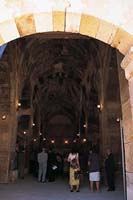 Sarıhan (Saruhan): It is on the Avanos - Ürgüp road, and 25 kilometers away from Nevşehir and 6 kilometers away from Avanos. It is estimated that a Seljukian piece of art, Sarıhan is constructed on 1238. It is composed of the structure in classic sultan inns plan, summer division with square courtyard, as well as closed and rectangular shaped winter division.
Sarıhan (Saruhan): It is on the Avanos - Ürgüp road, and 25 kilometers away from Nevşehir and 6 kilometers away from Avanos. It is estimated that a Seljukian piece of art, Sarıhan is constructed on 1238. It is composed of the structure in classic sultan inns plan, summer division with square courtyard, as well as closed and rectangular shaped winter division.
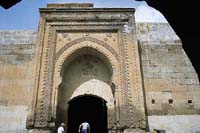 Ağzıkara Inn: It is on the Aksaray - Nevşehir road, and 17 kilometers away from Aksaray, as well as it is one of the most important inns in Anatolia. It is understood that the structure, which is Sejukian piece of art and also known as Hoca Mesut Caravansary, is constructed between 1231 - 1236 from the inscription on the corolla doors of open and closed divisions. It has an impressive appearance with its monumental corolla door, its niches and geometrical motif adorned side, and shows all beauties of Seljukian rock adornment art.
Ağzıkara Inn: It is on the Aksaray - Nevşehir road, and 17 kilometers away from Aksaray, as well as it is one of the most important inns in Anatolia. It is understood that the structure, which is Sejukian piece of art and also known as Hoca Mesut Caravansary, is constructed between 1231 - 1236 from the inscription on the corolla doors of open and closed divisions. It has an impressive appearance with its monumental corolla door, its niches and geometrical motif adorned side, and shows all beauties of Seljukian rock adornment art.
Sultan Inn: Sultan Inn is on the Aksaray - Konya road and within Sultanhanı borough 42 kilometers away from Aksaray, and it is constructed by Seljukian Sultan, Ist Alaaddin Keykubad on 1229. Structure which has approximately an area of 4990 m2 with its open and closed divisions, is the biggest Seljukian caravansary in Anatolia. It is remembering a castle with its marble corolla door made up of advanced rock, and its walls supported by towers outside. Corolla door and small mosque's geometrical adornments, are the best samples of Seljukian rock adornment art.
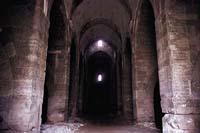 Zazadin Inn: It is 22 kilometers away from Konya, and adjacent to 5 kilometers from Aksaray - Konya road Tömek village, and also known as Saadeddin Köpek Inn, Zazadin Han, is constructed between 1235 - 1236. Open division corolla door at south side, near to the closed division, is constructed with white and light brown rocks. During the construction of south side, lots of processed antique rock is used. There is a small mosque which has a rich rock adornment and to which you can reach by stages engraved into wall within the massive blocks of corolla door.
Zazadin Inn: It is 22 kilometers away from Konya, and adjacent to 5 kilometers from Aksaray - Konya road Tömek village, and also known as Saadeddin Köpek Inn, Zazadin Han, is constructed between 1235 - 1236. Open division corolla door at south side, near to the closed division, is constructed with white and light brown rocks. During the construction of south side, lots of processed antique rock is used. There is a small mosque which has a rich rock adornment and to which you can reach by stages engraved into wall within the massive blocks of corolla door.
Kızılören Inn: Kızılören Inn is on Konya - Beyşehir road and 41 kilometers away from Konya, is constructed by Seljukian Sultan, Ist Gıyaseddin Keyhüsrev between 1206 - 1207.
Ertokuş Inn: It is on Beyşehir - Eğirdir road and at Yeşilköy locality of Gelendost province. It is understood from its inscription on closed division door that it is constructed on 1233.
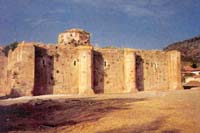 Susuz Inn: It is within Susuzköy of Bucak province, 2 kilometers inside of the Burdur - Antalya road. It is estimated that Susuz Inn is constructed at a date between 1237 and 1246 during IInd Gıyaseddin Keyhüsrev's sovereignty period. Its most impressive part is corolla door. "Angel" and "dragon" motifs on the arches of the niches at both sides of the entrance are drawing attention.
Susuz Inn: It is within Susuzköy of Bucak province, 2 kilometers inside of the Burdur - Antalya road. It is estimated that Susuz Inn is constructed at a date between 1237 and 1246 during IInd Gıyaseddin Keyhüsrev's sovereignty period. Its most impressive part is corolla door. "Angel" and "dragon" motifs on the arches of the niches at both sides of the entrance are drawing attention.
Kırkgöz Inn: It is approximately one kilometers inside the Burdur - Antalya road and 30 kilometers away from Antalya. According to the inscription on the open division corolla door, inn is constructed at a date between 1237 and 1246 during IInd Gıyaseddin Keyhüsrev's sovereignty period.
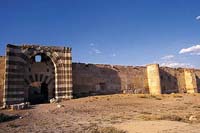 Alara Inn: It is near to the Alara castle, which took a strategic role on controlling the Mediterranean reaching roads, and 115 kilometers away from Antalya, 8 kilometers inside Antalya - Alanya road. It is constructed on 1229 - 1230 by Sultan Alaaddin Keykubad.
Alara Inn: It is near to the Alara castle, which took a strategic role on controlling the Mediterranean reaching roads, and 115 kilometers away from Antalya, 8 kilometers inside Antalya - Alanya road. It is constructed on 1229 - 1230 by Sultan Alaaddin Keykubad.
Hunat Hatun Mosque: It is at the city center of Kayseri, and composes a part of the külliye, constructed on 1238 by wife of Seljukian Sultan, Alaaddin Keykubad, Mahperi Hatun. Its dome and minaret had been constructed afterwards. Its corolla doors at east and west directions, are the most beautiful samples of Seljukian stone masonry. Its wooden balcony is original. 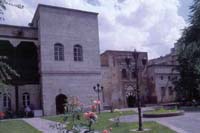
Gevher Nesibe Sultan Medical Musemum: Gıyasiye Theology School and Cure House which is in the Mimar Sinan Park in Kayseri, is constructed in connection with testament of his sister, Gevher Nesibe Sultan by Seljukian Sultan, Ist Gıyaseddin Keyhüsrev during XIIIth century. It is the first applied medical school of the world.
Güpgüpoğlu Mansion: This structure is at the city center of Kayseri, and a beautiful sample for XVIIIth century civil architecture. Two layers are added to this originally single layered mansion afterwards.
Zelve Open Air Museum: Selve ruins, which is composed of three valley and 5 kilometers away from Avanos, is the most earth pillars are found place. It had become a religious center with constructed monastery and churches during iconoclastic age. Village in Zelve, which is settled till 1952, had been moved to 3 kilometers away and Zelve become an open air museum.
Göreme Open Air Museum: In Göreme Open Air Museum, which is 13 kilometers away from Nevşehir, and 1,5 kilometers away from Göreme borough, there are monasteries, pantries, kitchen, mess hall besides churches adorned with frisk and constructed with engraving into rocks during various ages.
Derinkuyu Underground City: It is on Nevşehir - Niğde road, 30 kilometers away from Nevşehir. It is founded by first Christians with the aim of sheltering. There are a big church, conference hall, sin confession chamber, ventilation shafts, pantries, barns and an earth hole oven within the underground city. It is estimated that currently 8 floors of it open for visiting, Derinkuyu is the biggest underground city of the region with its 2,5 km2 reaching area.
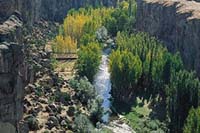 Ihlara (Peristrama) Valley: Ihlara Valley is formed as a result of erosion with external impacts on tuff layer formed by lava erupted from Mount Hasan during third geological period on which big changes have occurred in the world. Melendiz stream with thermal characteristic, who found its path within the cracks of this erosion convenient layers, had formed this valley with canyon appearance whose height reaches 110 meters from time to time and 14 kilometers long as a result of millions of years period. Valley, starts in Ihlara (Yeşilyurt) village, and ends in Selime village. lhlara valley, is famous with its historical places as much as its natural beauties. During the initial periods of Christianity, it became one of the most trustworthy shelters - regions of Cappadocia. Lots of churches, monastery and caverns turned into houses. It is thought that frisks in today visiting churches are painted between 9th and 13th centuries. Mostly Eastern effects can be seen on frisks made during initial period. Bizantium method is dominant on churches dated 10th and 11th centuries and dense in Belisırma village.
Ihlara (Peristrama) Valley: Ihlara Valley is formed as a result of erosion with external impacts on tuff layer formed by lava erupted from Mount Hasan during third geological period on which big changes have occurred in the world. Melendiz stream with thermal characteristic, who found its path within the cracks of this erosion convenient layers, had formed this valley with canyon appearance whose height reaches 110 meters from time to time and 14 kilometers long as a result of millions of years period. Valley, starts in Ihlara (Yeşilyurt) village, and ends in Selime village. lhlara valley, is famous with its historical places as much as its natural beauties. During the initial periods of Christianity, it became one of the most trustworthy shelters - regions of Cappadocia. Lots of churches, monastery and caverns turned into houses. It is thought that frisks in today visiting churches are painted between 9th and 13th centuries. Mostly Eastern effects can be seen on frisks made during initial period. Bizantium method is dominant on churches dated 10th and 11th centuries and dense in Belisırma village.